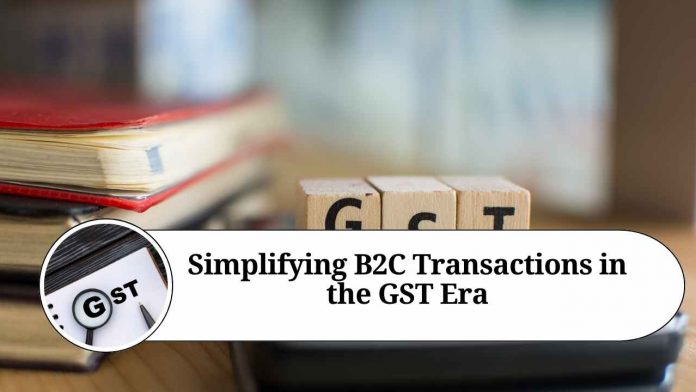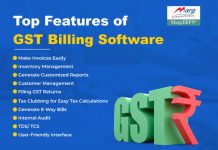The Goods and Services Tax (GST) has revolutionized the way businesses operate in many countries worldwide. It is a comprehensive indirect tax system that aims to streamline taxation processes, increase transparency, and create a unified market. While much attention is given to the impact of GST on businesses engaged in B2B transactions, it is equally important to understand its implications on B2C transactions. In this blog post, we will explore the key aspects of B2C transactions in the GST framework and how it has simplified the landscape for businesses and consumers alike.
Understanding B2C Transactions
B2C transactions refer to the sale of goods or services from a business to the end consumer. It encompasses a wide range of activities, including retail sales, online purchases, and services provided directly to individuals. Before the introduction of GST, different indirect taxes, such as Value Added Tax (VAT), Central Excise, and Service Tax, governed these transactions. However, the implementation of GST has streamlined and simplified the tax structure.
Benefits of GST in B2C Transactions
- Single Tax Regime: One of the significant advantages of GST in B2C transactions is the elimination of multiple indirect taxes. Under the previous system, businesses had to comply with various tax laws, making the process complex and time-consuming. With GST, there is a single tax regime, reducing the compliance burden for businesses and ensuring uniformity across the country.
- Input Tax Credit (ITC): GST allows businesses to claim Input Tax Credit on the taxes paid on inputs or raw materials used in the production or delivery of goods and services. This benefit extends to B2C transactions as well, as businesses can offset the taxes paid on inputs against the tax liability on final products. It enables businesses to reduce costs and offer competitive prices to consumers.
- Higher Threshold for Registration: Under the earlier tax regime, businesses were required to register for VAT or other taxes once their turnover crossed a certain threshold. This threshold was relatively low, resulting in a large number of small businesses having to comply with complex tax laws. With GST, the threshold for registration has been significantly increased, exempting many small businesses from the registration process. This has eased the burden on small-scale enterprises and encouraged entrepreneurship.
- Increased Compliance and Transparency: GST introduced a robust IT infrastructure that enables seamless filing of returns, e-invoicing, and real-time tracking of transactions. This has improved compliance levels among businesses and enhanced transparency in the entire supply chain. Consumers benefit from this increased transparency as they can verify the taxes paid by businesses and make informed choices.
- Removal of Cascading Effect: The cascading effect, also known as tax-on-tax, was a common problem in the earlier tax regime. It occurred when businesses paid taxes on inputs and then again on the final product, leading to higher prices for consumers. GST eliminates this cascading effect by allowing businesses to claim Input Tax Credits, ensuring that taxes are levied only on the value added at each stage of the supply chain. This results in a more efficient and cost-effective system.
Conclusion
The introduction of GST has undoubtedly simplified the B2C landscape by creating a unified tax system, promoting transparency, and reducing the compliance burden for businesses. It has brought numerous benefits, such as the availability of Input Tax Credits, the increased threshold for registration, improved compliance levels, and the elimination of the cascading effect. With a streamlined tax structure and simplified processes, businesses can focus on growth and consumers can enjoy the benefits of a more transparent and efficient tax system. As GST continues to evolve, businesses and consumers need to stay updated with any changes and leverage the advantages it offers.
Other Related Blogs: Section 144B Income Tax Act
Frequently Ask Question
Q1: What does B2C mean in the context of GST?
A1: B2C stands for “Business-to-Consumer” and refers to transactions where a business sells goods or services directly to the end consumer.
Q2: How does GST impact B2C transactions?
A2: GST has streamlined the taxation process for B2C transactions by replacing multiple indirect taxes with a single tax regime. It has simplified compliance, increased transparency, and reduced the tax burden for businesses and consumers.
Q3: Are there any thresholds for businesses engaging in B2C transactions to register under GST?
A3: Yes, businesses engaged in B2C transactions are required to register under GST if their annual turnover exceeds the specified threshold. However, the threshold for registration has been significantly increased under GST, exempting many small businesses from the registration process.
Q4: Can businesses claim Input Tax Credit (ITC) on B2C transactions?
A4: Generally, businesses cannot claim Input Tax Credits on taxes paid for inputs used in B2C transactions. However, businesses can claim ITC for taxes paid on inputs used in the production or delivery of goods and services, even if they are eventually sold to consumers.
Q5: How has GST simplified compliance for businesses involved in B2C transactions?
A5: GST has introduced a robust IT infrastructure that facilitates the seamless filing of returns and enables real-time tracking of transactions. It has reduced the compliance burden by eliminating the need to comply with multiple tax laws and providing a unified tax system.
Q6: What is the impact of GST on pricing in B2C transactions?
A6: GST has helped eliminate the cascading effect or tax-on-tax, which existed under the previous tax regime. This means businesses can claim Input Tax Credits, reducing costs and allowing them to offer competitive prices to consumers.
Q7: How has GST increased transparency in B2C transactions?
A7: GST has introduced e-invoicing and a digital record-keeping system, which enhances transparency in B2C transactions. Consumers can verify the taxes paid by businesses and make informed choices, while businesses benefit from a more transparent supply chain.
Q8: Are there any specific compliance requirements for businesses engaged in online B2C transactions?
A8: Businesses engaged in online B2C transactions are required to comply with the same GST regulations as other businesses. Additionally, they may need to adhere to specific regulations related to electronic commerce, such as tax collection at source (TCS) for e-commerce operators.
Q9: Are there any exemptions or special provisions for small businesses engaged in B2C transactions under GST?
A9: Yes, GST provides a higher threshold for registration, exempting many small businesses from the registration process. This has eased the compliance burden for small-scale enterprises and encourages entrepreneurship.
Q10: How can businesses and consumers stay updated with changes in GST regulations related to B2C transactions?
A10: Businesses and consumers need to stay informed about any changes in GST regulations. They can regularly visit the official GST website, consult tax professionals, or subscribe to reliable sources of information to stay updated with the latest developments in GST laws and their impact on B2C transactions.




















